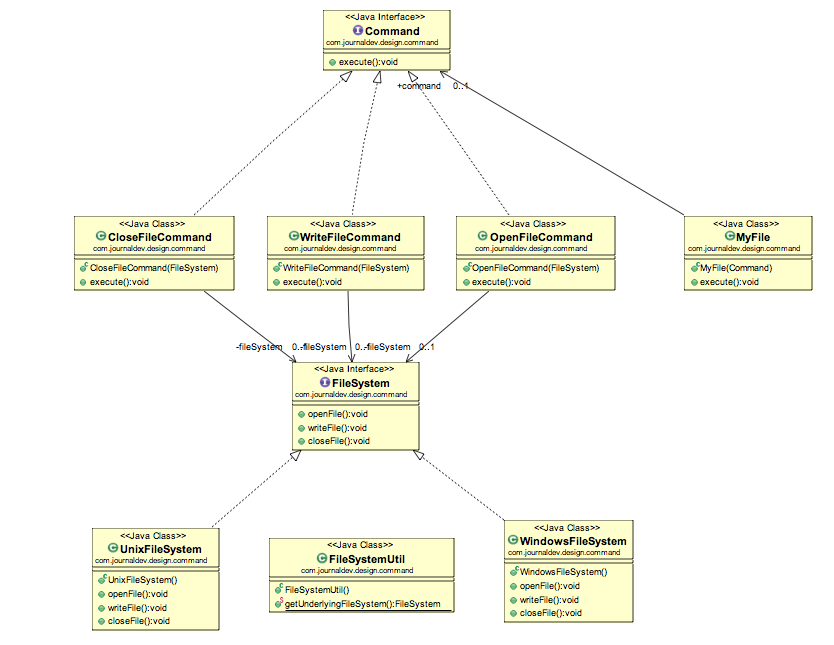Table Of Content
- What is the difference between Command and Strategy Design Patterns?
- How does the Command Design Pattern relate to object-oriented design principles?
- Advantages of the Command Pattern in C++ Design Patterns
- Support our free website and own the eBook!
- Components of the Command Design Pattern
- Behvioural Design Patterns

Finally, we create the client class RemoteApplication responsible for creating the concrete command objects and assigning them to the Invoker. Our file system utility implementation is ready and we can move to write a simple command pattern client program. But before that I will provide a utility method to create the appropriate FileSystemReceiver object.
What is the difference between Command and Strategy Design Patterns?
This approach is, for instance, used in the Windows Presentation Foundation (WPF). The client code (GUI elements, command history, etc.) isn’t coupled to concrete command classes because it works with commands via the command interface. This approach lets you introduce new commands into the app without breaking any existing code. In command design patterns, we create command objects for the above-mentioned On, Off, Up, and Down commands. The Command Design Pattern is a Behavioral Design pattern that turns a request into a stand-alone object that contains all information about the request.
How does the Command Design Pattern relate to object-oriented design principles?
The client program create the receiver object and then attach it to the Command. Then it creates the invoker object and attach the command object to perform an action. Now when client program executes the action, it’s processed based on the command and receiver object. The Command Interface is like a rulebook that all command classes follow. It declares a common method, execute(), ensuring that every concrete command knows how to perform its specific action. It sets the standard for all commands, making it easier for the remote control to manage and execute diverse operations without needing to know the details of each command.
Advantages of the Command Pattern in C++ Design Patterns
DEVCOM SC’s Cold Temperature and Arctic Protection System serves Soldiers in austere environments - United States Army
DEVCOM SC’s Cold Temperature and Arctic Protection System serves Soldiers in austere environments.
Posted: Tue, 04 Apr 2023 07:00:00 GMT [source]
The Command pattern allows requests to be encapsulated as objects,thereby allowing clients to be parametrized with different requests.The "check" at a diner is an example of a Command pattern. The waiteror waitress takes an order or command from a customer and encapsulatesthat order by writing it on the check. Note that the pad of "checks" used by each waiter isnot dependent on the menu, and therefore they can support commands tocook many different items. This is an interface or abstract class that declares an execute method, defining the contract for concrete commands. It ensures that all commands have a method to perform their actions.
Order, i.e., what kind of food the customer wants, is the Command. So, the Waiter passes the request to the Receiver, i.e., the Cook, who will prepare the food and give it back to the Waiter, and the Waiter gives it back to the customer. Ignatius Teo is a freelance PHP programmer and has been developing n-tier web applications since 1998. In his spare time he enjoys dabbling with Ruby, martial arts, and playing Urban Terror.
Components of the Command Design Pattern
What the Invoker will do is it will call the Execute method of the Command Object. The Execute method of the command object will be called the Receiver Object Method. The Receiver Object Method will perform the necessary action to handle the request. For a better understanding, please have a look at the following diagram. As with any other object, a command can be serialized, which means converting it to a string that can be easily written to a file or a database.
This transformation allows you to parameterize methods with different requests, delay or queue a request’s execution, and support undoable operations. It’s useful in scenarios where you need to issue requests without knowing anything about the operation being requested or the receiver of the request. Furthermore, it supports undoable operations, as every command is an object with a specific method. The next step is to make your commands implement the same interface.
Behvioural Design Patterns
The Invoker Object (i.e., Menu Options) does not know how to handle the requests. So, what the Invoker Object will do is he will call the Execute method of the command object. As you can see, the menus have Open, Save, and Close options. The Execute Method of the command object will be called the Open Method of the Document Object. Similarly, the Save Command has the request to save a document.
Text editor commands and undo
Initially, when our app only had the toolbar, it was okay to place the implementation of various operations into the button subclasses. In other words, having the code for copying text inside the CopyButton subclass was fine. This structural code demonstrates the Command pattern which stores requests as objects allowing clients to execute or playback the requests.
The invoker class holds a reference to a Command object and triggers its execution through the execute() method. The invoker doesn’t know the specific details of the command or the devices. It simply calls the execute() method on the current command, allowing for flexible and dynamic control over different devices. As per the Command Design Pattern, the command object has three things. The second one is the Receiver object reference, and the third is the Execute method, which will call the receiver object method to handle the request. This information includes the method name, the object that owns the method and values for the method parameters.
These classes act as executable instructions that the remote control can trigger without worrying about the nitty-gritty details of how each command accomplishes its task. The invoker is responsible for triggering the execution of commands. It holds references to the commands and can execute them. It acts as an intermediary between the sender (client) and the receiver, ensuring that the sender remains decoupled from the receiver.
This is possible because objects are a central OOP concept, and languages provide many different ways to interact with them. Use this pattern whenever you want to create actions that can be executed on receivers at a later point in time. For example, you can create and store commands to be performed by a computer AI, and then execute these over time. We need to create three command classes by implementing the above ICommand interface. Yes, the Command Design Pattern can support undoable operations.
This file system utility should support multiple operating systems such as Windows and Unix. To implement our File System utility, first of all we need to create the receiver classes that will actually do all the work. Since we code in terms of interface in java, we can have FileSystemReceiver interface and it’s implementation classes for different operating system flavors such as Windows, Unix, Solaris etc.

No comments:
Post a Comment